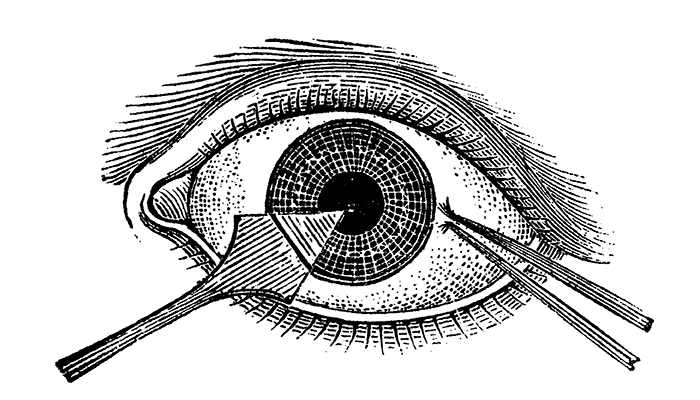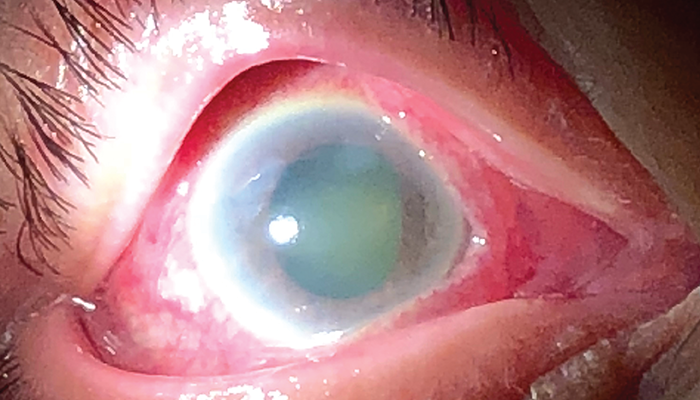
Credit: Shutterstock.com
Greece (460-300 BCE)
In the Hippocratic era, cataract couching was not well-known in Greece. In this era, the glaukos eye was the lightest eye, regardless of whether the eye was healthy or diseased. Healthy glaukos eyes were blue, green, or light gray. In the setting of disease, a bright glaukos eye involved a gray or green media opacity. Medical treatments could be attempted, and the diseased glaukos eye might improve. The diseased glaukos eye probably represented a variety of etiologies producing a very light or bright eye: extensive keratitis, corneal scarring or edema, angle-closure glaucoma, vitamin A deficiency, pannus, and so on.
The early couching era (to 1500 CE)
Couching for cataracts was more frequently described along the Mediterranean. A couchable cataract seen through an undilated pupil made the brown eye typical along the Mediterranean look just a bit brighter. Because goats have an eye color of intermediate brightness (amber), such eyes, whether healthy or diseased, were called a “goat’s eye” by the Greeks. The myth that a goat discovered cataract couching by accidentally impaling its eye on a thorn might have served as a teaching tool to help remember that couching worked for eyes of intermediate brightness.
On the other hand, the diagnoses that produced the brightest glaukos eye (for example, extensive keratitis) did not improve with couching, and so glaucoma was described as surgically “incurable.” In subsequent writings, the words for a healthy blue eye (nīla in Sanskrit and zarqaa in Arabic) or green eye (viridis in medieval Latin), also described eyes with surgically-incurable blindness. In the Medieval Arabic period, clusters of several glaucomatous signs or symptoms (for example, a bright eye, a pressure sensation, pain, mydriasis, incurability) might be described (1).
The enlightenment (1600–1850)
In 1622, Richard Banister of England described the incurable, palpably hard eye with a green crystalline lens.
Beginning in the late 1600s, acupuncture was imported from Asia to Europe. East Asian doctors also performed anterior chamber paracentesis. European oculists viewed themselves as performing acupuncture when they performed anterior chamber paracentesis for “hydrophthalmia,” which corresponded with a variety of conditions, including angle-closure glaucoma.
In the 1700s, some ophthalmologists used a magnifying glass to examine the eye. Multiple authors clearly described angle-closure glaucoma: pain, conjunctival injection, a palpably hard eye, mydriasis, an anteriorly prominent lens, difficulty in surgical cure (only palliation possible), an anteriorly bowed iris, a narrow anterior chamber, and visual field defects.
John Thomas Woolhouse called this condition “glaucome” in 1707, following ancient writers who used the term to describe crystalline lens disorders. Some authors noted a green pupil in glaucoma. Indeed, patients with the mydriasis of angle-closure glaucoma do sometimes have a green or gray pupil (see Figure 1).

Figure 1. Angle-closure glaucoma can produce a green pupil when the mid-dilated pupil exposes the opalescent lens.
You can read Part 2 of The History of Glaucoma here.
Further reading
CT Leffler, “An Introduction to the History of Glaucoma,” in The History of Glaucoma, xi, Wayenborgh: 2020.
CT Leffler et al., “What was glaucoma called before the 20th century?” Ophthalmology and Eye Diseases, January 2015. PMID: 26483611.
CT Leffler et al.,“The early history of glaucoma: the glaucous eye (800 BC to 1050 AD),” Clinical Ophthalmology, 207 (2015). PMID: 25673972.
CT Leffler et al., “Cataract couching and the goat's eye,” Acta Ophthalmologica, 96, 755 (2018). PMID: 30259681.
CT Leffler et al., “The history of cataract surgery: from couching to phacoemulsification,” Annals of Translational Medicine (2020). PMID: 33313296.
References
- CT Leffler et al., “Glaucoma in the Medieval Arabic World,” in CT Leffler (ed.), The History of Glaucoma,” 47, Wayenborgh: 2020.
